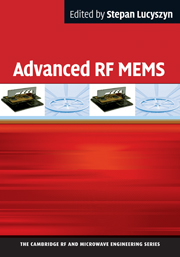Book contents
- Frontmatter
- Dedication
- Contents
- List of Contributors
- Preface
- List of Abbreviations
- 1 Introduction
- 2 Electromechanical modelling of electrostatic actuators
- 3 Switches and their fabrication technologies
- 4 Niche switch technologies
- 5 Reliability
- 6 Dielectric charging
- 7 Stress and thermal characterisation
- 8 High-power handling
- 9 Packaging
- 10 Impedance tuners and tuneable filters
- 11 Phase shifters and tuneable delay lines
- 12 Reconfigurable architectures
- 13 Industry roadmap for RF MEMS
- Author biographies
- Index
- References
10 - Impedance tuners and tuneable filters
Published online by Cambridge University Press: 05 February 2014
- Frontmatter
- Dedication
- Contents
- List of Contributors
- Preface
- List of Abbreviations
- 1 Introduction
- 2 Electromechanical modelling of electrostatic actuators
- 3 Switches and their fabrication technologies
- 4 Niche switch technologies
- 5 Reliability
- 6 Dielectric charging
- 7 Stress and thermal characterisation
- 8 High-power handling
- 9 Packaging
- 10 Impedance tuners and tuneable filters
- 11 Phase shifters and tuneable delay lines
- 12 Reconfigurable architectures
- 13 Industry roadmap for RF MEMS
- Author biographies
- Index
- References
Summary
Introduction
RF impedance tuners and tuneable filters are essential components in front-end architectures for communication systems operating up to several gigahertz. Because of the recent increase of communication standards (e.g. GSM, WLAN, Wi-Fi, WiMAX, etc.), it has become necessary to produce systems with advanced reconfigurable capabilities. These demands have triggered an important R&D effort for proposing novel approaches to synthesise electronically – or magnetically-reconfigurable RF tuners and filters. Several enabling technologies are available to make them tuneable, such as the use of (i) yttrium iron garnet (YIG) crystals; (ii) solid-state (varactors and switches); (iii) ferroelectric- or ferromagnetic-based components; and (iv) mechanical or MEMS devices. Depending on the final application, a pertinent technological choice is then generally made by taking into account compromises between several factors, such as system complexity, reconfigurability, speed, size and costs. Additional requirements also have to be considered, such as maximum tolerated losses, linearity, dc power consumption and RF signal power handling. In particular, trends in communication systems are mainly focused on compact, high-efficiency and high-Q-factor systems having low-signal-distortion capabilities.
With basic RF filter design, the waveguide or dielectric resonator technologies generally enable very selective and low-loss filtering, especially when high RF power capabilities are needed. However, these devices suffer from integration difficulties due to their large size and weight. In contrast, planar technologies (e.g. microstrip, stripline or CPW) benefit from their compactness and ease of integration, but at the cost of medium- to low-Q-factor performance. Alternative solutions that have been developed in the past few years for obtaining both filter design compactness and improved Q-factor are oriented towards the use of silicon bulk micromachining techniques for suspending the RF filters on thin membranes [1] or the implementation of acoustic wave resonator technologies [2]. Other intensively studied approaches include loss compensation methods based on MMIC negative resistance technologies [3], exhibiting very attractive RF performance, but at the expense of high dc power consumption. Impedance tuners have been the subject of similar technological developments, with the main objective being to synthesise larger impedance coverage.
- Type
- Chapter
- Information
- Advanced RF MEMS , pp. 271 - 306Publisher: Cambridge University PressPrint publication year: 2010
References
- 1
- Cited by



